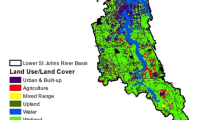Abstract
Twenty-three Section 404 permits in central Pennsylvania (covering a wetland age range of 1–14 years) were examined to determine the type of mitigation wetland permitted, how the sites were built, and what success criteria were used for evaluation. Most permits allowed for mitigation out-of-kind, either vegetatively or through hydrogeomorphic class. The mitigation process has resulted in a shift from impacted wetlands dominated by woody species to less vegetated mitigation wetlands, a trend that appears to be occurring nationwide. An estimate of the percent cover of emergent vegetation was the only success criterion specified in the majority of permits. About 60% of the mitigation wetlands were judged as meeting their originally defined success criteria, some after more than 10 years. The permit process appears to have resulted in a net gain of almost 0.05 ha of wetlands per mitigation project. However, due to the replacement of emergent, scrub–shrub, and forested wetlands with open water ponds or uplands, mitigation practices probably led to a net loss of vegetated wetlands.
Similar content being viewed by others
Author information
Authors and Affiliations
Rights and permissions
About this article
Cite this article
Cole, C., Shafer, D. Section 404 Wetland Mitigation and Permit Success Criteria in Pennsylvania, USA, 1986–1999. Environmental Management 30, 508–515 (2002). https://doi.org/10.1007/s00267-002-2717-4
Issue Date:
DOI: https://doi.org/10.1007/s00267-002-2717-4




